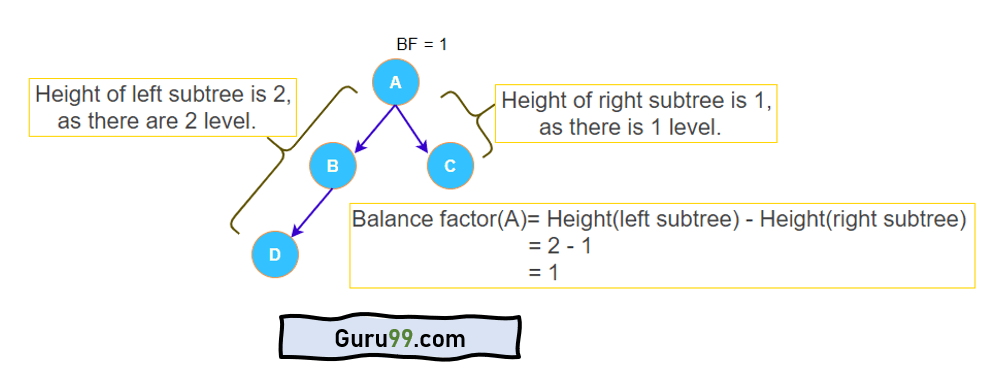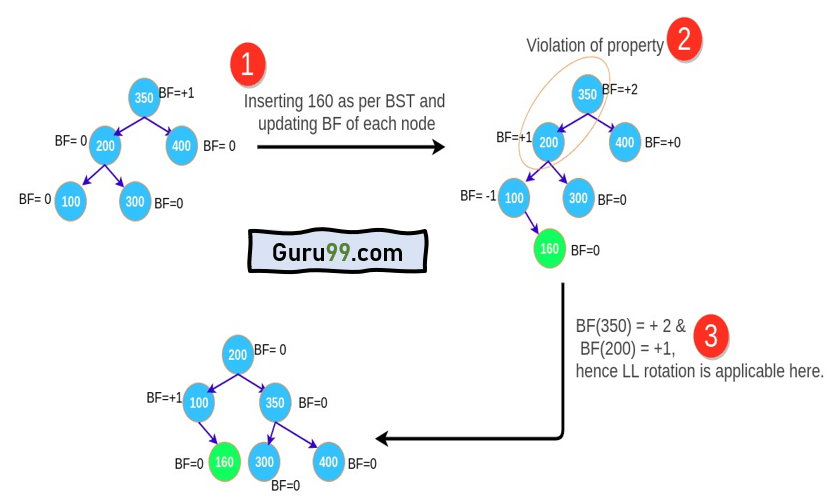Blog
10+ BEST Music Visualizers in 2021
Music visualizers are software that can generate animated imagery that follows loudness, frequency spectrum,...
AVL trees are binary search trees in which the difference between the height of the left and right subtree is either -1, 0, or +1.
AVL trees are also called a self-balancing binary search tree. These trees help to maintain the logarithmic search time. It is named after its inventors (AVL) Adelson, Velsky, and Landis.
In this Algorithm tutorial, you will learn:
To better understand the need for AVL trees, let us look at some disadvantages of simple binary search trees.
Consider the following keys inserted in the given order in the binary search tree.

The height of the tree grows linearly in size when we insert the keys in increasing order of their value. Thus, the search operation, at worst, takes O(n).
It takes linear time to search for an element; hence there is no use of using the Binary Search Tree structure. On the other hand, if the height of the tree is balanced, we get better searching time.
Let us now look at the same keys but inserted in a different order.
Here, the keys are the same, but since they are inserted in a different order, they take different positions, and the height of the tree remains balanced. Hence search will not take more than O(log n) for any element of the tree. It is now evident that if insertion is done correctly, the tree's height can be kept balanced.
In AVL trees, we keep a check on the height of the tree during insertion operation. Modifications are made to maintain the balanced height without violating the fundamental properties of Binary Search Tree.
Balance factor (BF) is a fundamental attribute of every node in AVL trees that helps to monitor the tree's height.

To make the AVL Tree balance itself, when inserting or deleting a node from the tree, rotations are performed.
We perform the following LL rotation, RR rotation, LR rotation, and RL rotation.
This rotation is performed when a new node is inserted at the left child of the left subtree.

A single right rotation is performed. This type of rotation is identified when a node has a balanced factor as +2, and its left-child has a balance factor as +1.
This rotation is performed when a new node is inserted at the right child of the right subtree.
A single left rotation is performed. This type of rotation is identified when a node has a balanced factor as -2, and its right-child has a balance factor as -1.
This rotation is performed when a new node is inserted at the right child of the left subtree.
This rotation is performed when a node has a balance factor as –2, and its right-child has a balance factor as +1.
This rotation is performed when a new node is inserted at the right child of the left subtree.
This rotation is performed when a node has a balance factor as +2, and its right-child has a balance factor as -1.
Insert operation is almost the same as in simple binary search trees. After every insertion, we balance the height of the tree. Insert operation takes O(log n) worst time complexity.

Step 1:Insert the node in the AVL tree using the same insertion algorithm of BST. In the above example, insert 160.
Step 2:Once the node is added, the balance factor of each node is updated. After 160 is inserted, the balance factor of every node is updated.
Step 3:Now check if any node violates the range of the balance factor if the balance factor is violated, then perform rotations using the below case. In the above example, the balance factor of 350 is violated and case 1 becomes applicable there, we perform LL rotation and the tree is balanced again.
Deletion is also very straight forward. We delete using the same logic as in simple binary search trees. After deletion, we restructure the tree, if needed, to maintain its balanced height.
Step 1: Find the element in the tree.
Step 2: Delete the node, as per the BST Deletion.
Step 3: Two cases are possible:-
Case 1: Deleting from the right subtree.
Case 2: Deleting from left subtree.
Below is the C++ code that implements AVL trees:
#include <iostream>
#include <queue>
#include <unordered_map>
using namespace std;
struct node {
struct node *left;
int data;
int height;
struct node *right;
};
class AVL
{
private:
public:
struct node * root;
AVL(){
this->root = NULL;
}
int calheight(struct node *p){
if(p->left && p->right){
if (p->left->height < p->right->height)
return p->right->height + 1;
else return p->left->height + 1;
}
else if(p->left && p->right == NULL){
return p->left->height + 1;
}
else if(p->left ==NULL && p->right){
return p->right->height + 1;
}
return 0;
}
int bf(struct node *n){
if(n->left && n->right){
return n->left->height - n->right->height;
}
else if(n->left && n->right == NULL){
return n->left->height;
}
else if(n->left== NULL && n->right ){
return -n->right->height;
}
}
struct node * llrotation(struct node *n){
struct node *p;
struct node *tp;
p = n;
tp = p->left;
p->left = tp->right;
tp->right = p;
return tp;
}
struct node * rrrotation(struct node *n){
struct node *p;
struct node *tp;
p = n;
tp = p->right;
p->right = tp->left;
tp->left = p;
return tp;
}
struct node * rlrotation(struct node *n){
struct node *p;
struct node *tp;
struct node *tp2;
p = n;
tp = p->right;
tp2 =p->right->left;
p -> right = tp2->left;
tp ->left = tp2->right;
tp2 ->left = p;
tp2->right = tp;
return tp2;
}
struct node * lrrotation(struct node *n){
struct node *p;
struct node *tp;
struct node *tp2;
p = n;
tp = p->left;
tp2 =p->left->right;
p -> left = tp2->right;
tp ->right = tp2->left;
tp2 ->right = p;
tp2->left = tp;
return tp2;
}
struct node* insert(struct node *r,int data){
if(r==NULL){
struct node *n;
n = new struct node;
n->data = data;
r = n;
r->left = r->right = NULL;
r->height = 1;
return r;
}
else{
if(data < r->data)
r->left = insert(r->left,data);
else
r->right = insert(r->right,data);
}
r->height = calheight(r);
if(bf(r)==2 && bf(r->left)==1){
r = llrotation(r);
}
else if(bf(r)==-2 && bf(r->right)==-1){
r = rrrotation(r);
}
else if(bf(r)==-2 && bf(r->right)==1){
r = rlrotation(r);
}
else if(bf(r)==2 && bf(r->left)==-1){
r = lrrotation(r);
}
return r;
}
void levelorder_newline(){
if (this->root == NULL){
cout<<"\n"<<"Empty tree"<<"\n";
return;
}
levelorder_newline(this->root);
}
void levelorder_newline(struct node *v){
queue <struct node *> q;
struct node *cur;
q.push(v);
q.push(NULL);
while(!q.empty()){
cur = q.front();
q.pop();
if(cur == NULL && q.size()!=0){
cout<<"\n";
q.push(NULL);
continue;
}
if(cur!=NULL){
cout<<" "<<cur->data;
if (cur->left!=NULL){
q.push(cur->left);
}
if (cur->right!=NULL){
q.push(cur->right);
}
}
}
}
struct node * deleteNode(struct node *p,int data){
if(p->left == NULL && p->right == NULL){
if(p==this->root)
this->root = NULL;
delete p;
return NULL;
}
struct node *t;
struct node *q;
if(p->data < data){
p->right = deleteNode(p->right,data);
}
else if(p->data > data){
p->left = deleteNode(p->left,data);
}
else{
if(p->left != NULL){
q = inpre(p->left);
p->data = q->data;
p->left=deleteNode(p->left,q->data);
}
else{
q = insuc(p->right);
p->data = q->data;
p->right = deleteNode(p->right,q->data);
}
}
if(bf(p)==2 && bf(p->left)==1){ p = llrotation(p); }
else if(bf(p)==2 && bf(p->left)==-1){ p = lrrotation(p); }
else if(bf(p)==2 && bf(p->left)==0){ p = llrotation(p); }
else if(bf(p)==-2 && bf(p->right)==-1){ p = rrrotation(p); }
else if(bf(p)==-2 && bf(p->right)==1){ p = rlrotation(p); }
else if(bf(p)==-2 && bf(p->right)==0){ p = llrotation(p); }
return p;
}
struct node* inpre(struct node* p){
while(p->right!=NULL)
p = p->right;
return p;
}
struct node* insuc(struct node* p){
while(p->left!=NULL)
p = p->left;
return p;
}
~AVL(){
}
};
int main(){
AVL b;
int c,x;
do{
cout<<"\n1.Display levelorder on newline";
cout<<"\n2.Insert";
cout<<"\n3.Delete\n";
cout<<"\n0.Exit\n";
cout<<"\nChoice: ";
cin>>c;
switch (c)
{
case 1:
b.levelorder_newline();
// to print the tree in level order
break;
case 2:
cout<<"\nEnter no. ";
cin>>x;
b.root = b.insert(b.root,x);
break;
case 3:
cout<<"\nWhat to delete? ";
cin>>x;
b.root = b.deleteNode(b.root,x);
break;
case 0:
break;
}
} while(c!=0);
}
Running example of above code:
g++ avl.cpp -o run
./run
Music visualizers are software that can generate animated imagery that follows loudness, frequency spectrum,...
The if else statement An if-else statement is a great tool for the developer trying to return an...
MAC includes a huge collection of the built-in app. However, there are many useful software that...
What is Computer Programming? COMPUTER PROGRAMMING is a step by step process of designing and...
R is a programming language. To use R, we need to install an Integrated Development Environment...
What is a Software Tester Resume? A software tester resume is a formal document that is mostly one or...